Technology descriptions

Finalized suite of technologies for CDCs
In the fall of 2017, after extensive consultation, the contents of the suite of technologies for Child Development Centres was finalized. Descriptions of each are included below:
Choices2Go software app for iPad
Accessible Remote Control Toy Car
In addition, each participating CDC identified its own “bonus technologies.” CDCs could choose extra units of the technologies above, or select one of the following devices:
Robotic Grabber (bonus technology)
Accessible Gaming Controller (bonus technology)
Choices2Go software app for iPad
Choices2Go is a software app for use on an iPad tablet that helps emergent communicators indicate their choices in everyday life and in therapy settings. CanAssist developed Choices2Go in collaboration with a speech-language pathologist from the Communication Association for Youth and Adults (CAYA). The app enables the rapid creation of “choice boards” using images from a photo library or camera roll.
 Clients are given a group of options and then encouraged to touch their choice, which is highlighted for several seconds. The app enables therapists and users to:
Clients are given a group of options and then encouraged to touch their choice, which is highlighted for several seconds. The app enables therapists and users to:
- create customized visual choice boards in seconds
- select from custom images, including albums and one’s own camera roll
- instantly access a pre-built Yes/No board
- shake to scramble the image order
What’s included?
- 3 iPad devices with preloaded Choices2Go app
- 3 protective iPad cases
Delivery schedule and instructional materials
Indoor Dog Ball Launcher
Many children who have never been able to throw a ball for a dog now have that opportunity at Sunny Hill Health Centre for Children in Vancouver.
Modifying a commercial product
Two devices were recently provided to Sunny Hill to enable youngsters with very challenging disabilities to send a ball flying through the air by pressing an accessibility switch – typically a large colorful button that sits on their wheelchair or lap.
CanAssist's engineering team took a commercial dog ball launcher and adapted it so that it could be activated using a switch.
Outcomes
“The dog ball launchers are fantastic in giving kids with limited mobility the opportunity to play independently with their dogs,” said Cheri Steele, a recreation therapist at Sunny Hill. It also helps the child develop his or her own relationship with a pet.
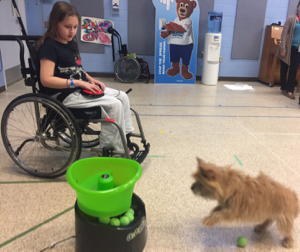 Steele said that the dog ball launcher is helping to motivate children to learn how to use an accessibility switch, a critical skill for many people with significant physical disabilities.
Steele said that the dog ball launcher is helping to motivate children to learn how to use an accessibility switch, a critical skill for many people with significant physical disabilities.
“There are many applications, as the ball launcher is very motivating for the kids,” said Steele. “The kids can learn the concept of cause and effect and practice targeting the switch. We can also change the position and size of the switch to help to improve their hand-eye coordination.”
Steele added that kids can also practice their mobility by chasing after the balls themselves – for example, by using their wheelchairs or walkers.
What’s included?
- 1 switch modified dog ball launcher
- 1 accessibility switch
Delivery schedule and instructional materials
Switch-Accessible Spinner
CanAssist’s Switch-Accessible Spinner is an electronic device designed to help children with very challenging disabilities participate in educational and therapeutic activities and to develop the crucial life skill of operating an accessibility switch.
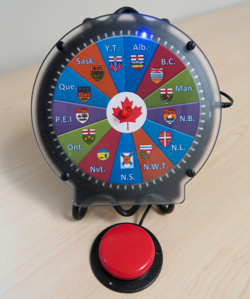 The Spinner is a circular device around which a point of light travels and eventually stops. A child activates the Spinner by pressing an attached accessibility switch with any part of the body over which he or she has control. A variety of changeable printed overlays can be attached to the Spinner and may show – for example – numbers, pictures, text, the six sides of a dice, or anything else the therapist or teacher wishes.
The Spinner is a circular device around which a point of light travels and eventually stops. A child activates the Spinner by pressing an attached accessibility switch with any part of the body over which he or she has control. A variety of changeable printed overlays can be attached to the Spinner and may show – for example – numbers, pictures, text, the six sides of a dice, or anything else the therapist or teacher wishes.
Encouraging use of a switch
For many children with severe disabilities, learning to use an accessibility switch is absolutely critical in being able to exert some control over their world because they can use it to activate a wide range of electronic devices, including communication devices and computers. Because the Spinner is light, compact and robust, it can be easily transported to and from any location and is expected to last for many years of continuous use by many children.
Outcomes
CanAssist recently provided 50 Spinners to the Provincial Inclusion Outreach Program (PIOP), which supports students with severe disabilities across the province and is funded by the BC Ministry of Education. PIOP Coordinator Chris Jenkins reports that the device has been such a success in increasing students’ participation in the classroom and their use of accessibility switches that his organization is hoping to acquire 50 more devices.
“For many of these kids, using a switch is a starting point in participating,” Jenkins explains. “It’s a way into that child’s world.”
In the classroom
For example, one student got to participate in the classroom in a way that was never possible before. The class had been studying the Panama Canal, so the teacher took a blank overlay and divided it into questions about the famous waterway. The non-verbal youngster using the Spinner was thus in charge of “asking” classmates different questions by pressing an accessibility switch.
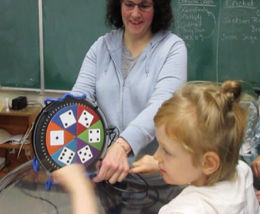
During a skipping event at another school, a student with a Spinner used an overlay on which were written different types of skipping styles, such as “forward,” “backward,” “double-Dutch” and so on. Using the Spinner, that student got to determine which types of skipping moves her peers would do next.
What’s included?
- 1 spinner device
- 10 printed and laminated overlays
- 1 accessibility switch
- 1 adjustable stand
Delivery schedule and instructional materials
Mobile Music Therapy Kit
Many young people enrolled in music therapy classes at the Victoria Conservatory of Music have very limited mobility, muscle control and dexterity. For some, it may be impossible to consistently control the movement of their fingers, arms, legs or breath. These types of challenges can greatly limit an individual’s ability to participate in creating music.
Increasing participation and inclusion
CanAssist worked with the Conservatory to develop a unique Mobile Music Therapy Kit. The kit includes several devices that enable people who can’t play standard instruments to create music independently. For example, the kit includes six iPods Touch devices, each loaded with CanAssist’s motion-activated music app, Waveband. An iPod is attached with Velcro straps to any part of the body over which the participant has some control. By moving the 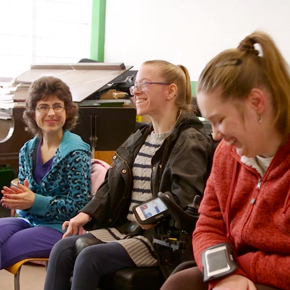 iPod, the person can create the individual notes of the instrument of his or her choice. The kit also includes four wireless accessibility switches that provide other ways for people to trigger sounds, including percussion.
iPod, the person can create the individual notes of the instrument of his or her choice. The kit also includes four wireless accessibility switches that provide other ways for people to trigger sounds, including percussion.
Outcomes
The multimedia kit is enabling people with very challenging disabilities to create music in ways they never have before.
Music therapist Allan Slade, who played a key role in providing feedback during the development process, says the kit has been very valuable in his practice.
“It opens up musical possibilities for more participants because of its physical adaptability,” he says. “Participants can now play from anywhere in the room and make music more easily….The whole music kit is a great package to help groups play together that would otherwise not be able to do so.”
A second iteration of the music kit is currently in development. The new kit will be lighter and more portable so that therapists can transport it easily among different locations.
A key component of both versions of the kit is CanAssist’s Waveband software app. The app is loaded on an iPod Touch and allows users to play a wide range of instruments by moving it around. The app allows therapists to determine how much movement is required to prompt a change in note, depending on the user’s capabilities around range of motion.
What’s included?
- 1 portable music kit base station
- 6 iPod Touch devices
- 4 wireless accessibility switches
Delivery schedule and instructional materials
Accessible Remote Control Toy Car
A few years ago, CanAssist developed a unique remote control toy car for a Grade 1 boy who doesn’t have the use of his hands. The toy was a terrific success, enabling the youngster both to participate independently in a fun activity and attract the positive attention and interaction of his classmates.
Since then, CanAssist has had several requests for children facing similar challenges. Over the past year, CanAssist has delivered toys to two clients in the Duncan area and to the Queen Alexandra Centre for Children’s Health in Victoria.
The Accessible Remote Control Toy Car gives children who cannot operate a standard remote control the chance to play with a cool toy independently using a joystick, accessibility switch or other input device.
Finding opportunities for play
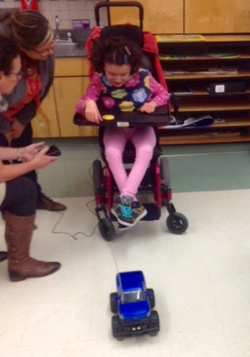 One client was nine-year-old Marina, who has a rare neurological disorder that affects the development of her brain and other parts of her body. The elementary school student is unable to operate a joystick, but can use an accessibility switch (often a large button that controls a wide range of electronic devices).
One client was nine-year-old Marina, who has a rare neurological disorder that affects the development of her brain and other parts of her body. The elementary school student is unable to operate a joystick, but can use an accessibility switch (often a large button that controls a wide range of electronic devices).
“It has been challenging to find opportunities for interactive play for Marina,” said Faye Hindle, the resource teacher who made the request.
To develop the devices, CanAssist purchased commercial toy cars that operate using two joysticks – one that controls forward-backward movement, the other that steers the car left and right. Engineers dismantled each toy’s remote control and interfaced it with a customized circuit. These changes allow children with challenging disabilities to control a car using one or more accessibility switches. Importantly, converting infrared to radio frequency codes allow children to operate remote controls for toys using the controls on their wheelchairs – which they are already proficient at using.
“It has been a really positive way of getting the kids at school to interact with Marina,” said Tania, the child’s mother. “It’s been a big success.”
What’s included?
- 1 radio controlled car or truck
- 1 switch converter
- 1 joystick
- 4 accessibility switches
Delivery schedule and instructional materials
Robotic Grabber
The Robotic Grabber was designed for a little boy who uses a wheelchair and is unable to reach down to pick up objects and put them in his lap.
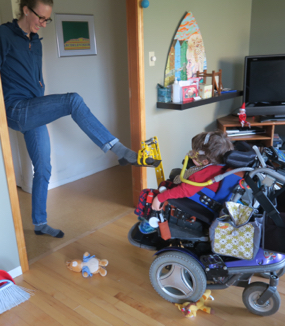 Leif, a four-year-old with significant mobility challenges, received his new device just before Christmas. Using a joystick controller, the youngster was immediately able to grip and pick up toys and other objects.
Leif, a four-year-old with significant mobility challenges, received his new device just before Christmas. Using a joystick controller, the youngster was immediately able to grip and pick up toys and other objects.
CanAssist designed the device to be very durable so it can be used indoors and outside. Safety features ensure the gripper doesn’t crush items being picked up and reduce the chance of damage to walls or floors.
Mounted to a power wheelchair, the device uses electronic linear actuators and its own battery to grip and lift the desired object.
After a thrilling first hour of picking up his favourite toys, Leif positioned his chair in front of his mom, smiled mischievously, and with a triumphant “Ha, ha!” proceeded to grab her foot. “For the first time ever, Leif is able to pick up toys off the floor,” said his mother, Emily. “This is amazing!”
What’s included?
- 1 robotic grabbing arm
- 1 joystick control
- universal mounting
Delivery schedule and instructional materials
Accessible Gaming Controller
CanAssist’s Accessible Gaming Controller (AGC) enables people with a wide range of disabilities to use popular gaming systems independently. The AGC acts as an intermediary between commercial gaming systems – such as PlayStation or Xbox – and a user's accessibility controls. These controls might include accessibility switches, joysticks or sip-and-puff devices.
 Leveling the playing field
Leveling the playing field
Several individuals and groups have received the device over the past several years and it has enabled them to play independently or with their peers and family members. The Accessible Gaming Controller levels the playing field for gamers with disabilities and those without.
For example, Canuck Place, a pediatric hospice and palliative care unit in Vancouver, received a system that works with both with Xbox and PlayStation video gaming systems. The device allows one child to play independently, or for two to play collaboratively.
Outcomes
In Victoria, Luke, who lives with cerebral palsy, including spastic quadriplegia, was never able to enjoy video gaming. But he and his family believed the activity would be a wonderful way to increase both his independence and – when playing with others – his sense of inclusion.
Luke’s solution allows him to roll up with his wheelchair in order to play. The station includes accessibility switch mounting, a fully adjustable stand, and an array of accessibility switches, including an oversized analogue joystick.
“Luke’s adapted gaming controller is a masterpiece of engineering!” Jim Cambridge, the teen’s dad, wrote to CanAssist. “The infinitely adjustable buttons and joystick allow Luke to enjoy the many games that typical youth have been using. He has moved from simple Windows games to full-on PS4 action and sports games.”
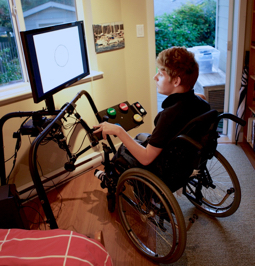 Being able to play video games means Luke can now participate in group gaming like everyone else. As a result, he has the opportunity to develop and maintain friendships that might otherwise not have been possible.
Being able to play video games means Luke can now participate in group gaming like everyone else. As a result, he has the opportunity to develop and maintain friendships that might otherwise not have been possible.
What’s included?
- 1 wheelchair accessible stand with switch mounting
- TV monitor
- 1 Xbox gaming console
- 1 switch converter device
- 2 joysticks
- 6 accessibility switches
- 4 games
Delivery schedule and instructional materials
Go to Top